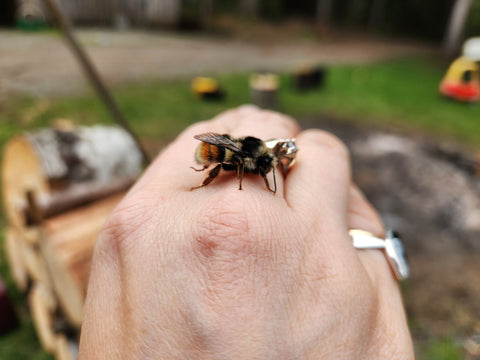Spring has fully arrived on Vancouver Island. The Southern Island always receives Spring in full force, weeks before we do. Questions file in about the caterpillars, the grubs and the big bumblebees hanging around the yard.


BC Natives: Red-flowering Currant, Ribes sanguineum. Pacific Bleeding Heart, Dicentra formosa
While we wake from our winter slumbers as well, it is important to remember not to jump right into tidying the fallen leaves and yard debris too early. These are the nesting sites of our local pollinators. I like to keep a less than tidy space with branches and leaf litter as compost, mulch over the gardens and flower spaces. It creates a perfect nesting site for my favorite friends, bumblebees.
So, take this spring time to relish in the warmth of the sun, take it slow and soak up as much of life as possible. While that is always easy to say, life sometimes has other plans. Life is about balance though and we must remember to rest and not always hustle about. Let's be more like bees!


We have recently moved our own nest home from a quaint beachside cottage to a cozy home in the woods. The opportunites to witness the native bombus on home turf has me sighting these beauties every day throughout the sunshine. The Tricolored Bumblebee, Bombus ternarius, is the first to emerge. I see her diligently searching the forest floor for a good nesting site. Attracted to dark patches in the leaf litter, each a potential nest site. She pays no mind to me as I sit quietly watching. It is the dog, my dog, who I need to keep at bay. He is the pest in this scenario and takes every opportunity to eat any bumbles he finds. His name is Louis and his passion for bumbles does not match my own. I digress, he is a pest in this regard but, a lovely pest all the same.

Bombus Ternarius? rescued from the clutches of Louis dog
The next spotting of bombus, Bombus vosnesenskii, the yellow-faced bumblebee is seen dutifully flying about. They are native to the area and the West coast and are the most abundant species of bumblebees. While they are the most abundant, our local native species have been on decline as well as many other insects, flora and fauna due to habitat loss. We can think back to our younger days, my own as well, and remember the windscreen on our cars being splattered with bug guts as we drive. Day or night, there was an array of insect remains all across the glass. Think on to this day, how much of that do we see on our windshields? This is alarming on many levels. (There are many articles that go into this notation written by many scientists and observers that I won't go into here but, if I can link to them at the bottom.)

A marbled green moth, clinging to a grass stalk.
Recently, I have received a book called, We Are the Ark by Mary Reynolds. In this book she explains how we must do our collective part in rewilding our spaces, bridging nature with our neighbours. All acts, no matter how small or insignificant it may seem, is important. We can do our part to plant native species for the local wildlife in our parcels of land, or in our planter boxes. The benefit is not only for the locals but, also for us as well! They take less water, grow for the area conditions and once established, are pretty carefree. That sounds like a win I will take because the less time I spend having to water my flower garden, the more time I have to spend watching the bees! Who am I kidding, I do not get to sit so often as I may like because well, children.


If you are interested in gardening and growing your own food, may I suggest also planting native species of plants? It will bring pollinators to your yard which in turn, help pollinate your crop which yields in bigger output. Now that is always worth it!
Some good resources to get started:
Xerces.org is a non-profit conservation society for invertabrates. They have lists of plants for your area and many ways on how we can help them out.
wearetheark.org is the website for the book I had mentioned. It is an easy read which garners hope for all of us.
Another way to find native species is to head to your local nurseries and plant shops and ask questions. There is bound to be some knowledge hidden there. And you may just come home with a new plant.
I am going to end this post by saying these are not paid endorsements. I am here to share the word for the animals that cannot speak for themselves.
